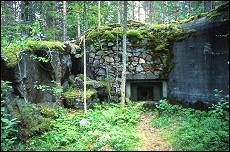
|

|

|
The protection covers antiquities of many ages. The picture shows a Viking Age burial cairn at Uimola in Rautjärvi and a Salpa Station bunker at Syyspohja in Ruokolahti.
Picture, South Karelian Museum / Arto Hämäläinen.
|
There are many kinds of antiquities of many different ages. In Finland, the spectrum ranges from the oldest dwelling site in Karijoki's Susiluola ("Wolf Cave") from more than 100,000 years ago, to the defence fortifications built at Salpa Station during the Second World War. Protected antiquities are defined in Finland's Antiquities Act. It is important to remember that there is no age restriction for protected antiquities.
The Antiquities Act lists as protected
- mounds of earth or stone, cairns, rings of stones, and other ancient man-made stone coverings and arrangements of long ago,
- graves and cemeterys from pagan times,
- stones and rock surfaces on which there are ancient writings, pictures, or other drawings or paintings, evidence of grinding or traces of carving or sacrificial indentations,
- sacrificial springs, trees or stones and other worship sites and ancient places of assembly,
- remains of ancient dwellings along with the dwelling and work sites, as well as formations which occurred from the usage of such dwellings or sites,
- abandoned ancient castles, hill forts, fortifications, strongholds, ramparts and moats, as well as their remains, churches, chapels, cloisters, and other notable ruins and ancient graves that are not within a cemetery maintained by the community,
- stones, crosses, and statues erected in olden times in memory of some individual or event or for religious purposes, and also other such monuments,
- remains of ancient notable travel routes, signposts, bridges, beacons and other such constructions of long ago, and
- non-movable natural objects connected with old traditions, tales, or significant historical memories.
The Antiquities Act also protects objects found in the ground which are more than 100 years old and whose owner is unknown. The artefacts should be brought without cleaning to the National Board of Antiquities, where they can be redeemed for a certificate of honour or for a finder's reward and added to the National Museum's collections. The artefacts may also be obtained for exhibition at the regional museum of the area where they were found. Artefacts that derive from a previously recognised ancient monument belong automatically to the collections of the National Museum without any redemption.
The law encompasses prehistoric and historic objects both on dry land and under water .
(Antiquities Act 295/63).
|
|
